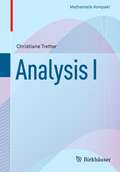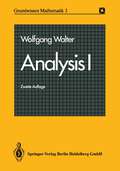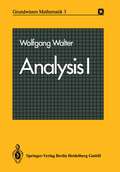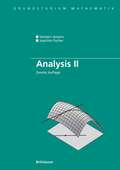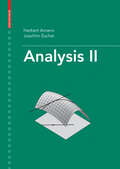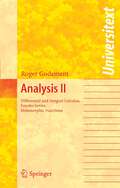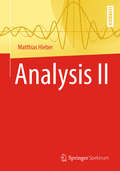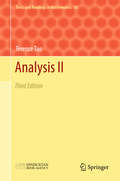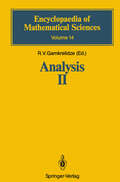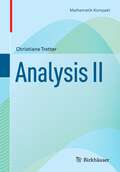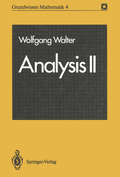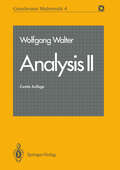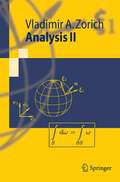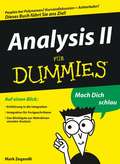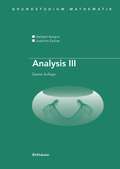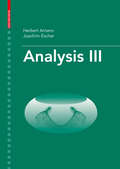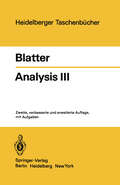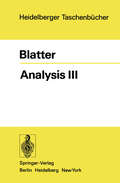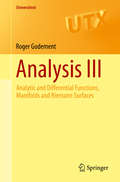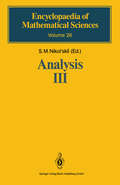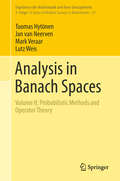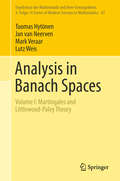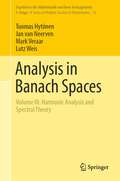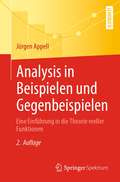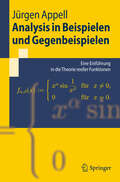- Table View
- List View
Analysis I (Mathematik Kompakt)
by Christiane TretterDas Lehrbuch ist der erste von zwei einführenden Bänden in die Analysis. Es zeichnet sich dadurch aus, dass alle klassischen Themen der Analysis des ersten Semesters kompakt zusammengefasst sind und dennoch auf typische Anfängerprobleme eingegangen wird. Neben einer Einführung in die formale Sprache und die wichtigsten Beweistechniken der Mathematik bietet der Band eingängige Erläuterungen zu abstrakten Begriffen. Alle prüfungsrelevanten Inhalte sind abgedeckt und können anhand von Beispielen, Gegenbeispielen und Aufgaben nachvollzogen werden.
Analysis I (Grundwissen Mathematik #3)
by Wolfgang WalterAus den Besprechungen: "Wodurch unterscheidet sich das hiermit begonnene Lehrwerk der Analysis von zahlreichen anderen, zum Teil im gleichen Verlag erschienenen, exzellenten Werken dieser Art? Mehreres ist zu nennen: (1) die ausführliche Berücksichtigung des Warum und Woher, der historischen Gesichtspunkte also, die in unserem von der Ratio geprägten Zeitalter ohnehin immer zu kurz kommen; (2) die Anerkennung der Existenz des Computers. Der Autor verschließt sich nicht vor der Tatsache, daß die Computermathematik (hier vor allem verstanden als numerische Mathematik) oft interessante Anwendungen der klassischen Analysis bietet. Als weitere attraktive Merkmale des Buches nennen wir (3) die große Fülle von Beispielen und nicht-trivialen (aber lösbaren) Übungsaufgaben, sowie (4) der häufige Bezug zu den Anwendungen. Man denke: Sogar die Theorie der gewöhnlichen Differentialgleichungen, vor der manche Lehrbuchautoren eine unüberwindliche Scheu zu haben scheinen, ist gut lesbar dargestellt, mit vernünftigen Anwendungen. Alles in Allem kann das Buch jedem Studierenden der Mathematik wegen der Fülle des Gebotenen und wegen des geschickten didaktischen Aufbaus auf das Wärmste empfohlen werden." ZAMP #1
Analysis I (Grundwissen Mathematik #3)
by Wolfgang WalterDas vorliegende Buch ist der erste Band eines zweibändigen Werkes über Analysis und behandelt die Funktionen einer reellen Veränderlichen. In der komplexen Analysis beschränkt es sich im wesentlichen auf Potenzreihen. Es enthält insbesondere den Stoff, welcher üblicherweise im ersten Semester einer einführenden Analysis-Vorlesung für Mathematiker, Physiker und Informatiker geboten wird, und geht an einigen Stellen darüber hinaus. Das Buch wendet sich an Studenten, denen es sich als ein hilfreicher Begleiter der Vorlesung und eine Quelle zur Vertiefung des Gegenstandes anbietet, an die im Beruf stehen den Mathematiker, besonders an die Lehrer an weiterführenden Schulen, und schließlich an alle, die etwas über die Analysis und ihre Bedeutung im größeren naturwissenschaftlichen und kulturellen Zusammenhang erfahren möchten. Damit sind wir bei einem wesentlichen Anliegen der Lehrbuchreihe "Grundwissen Mathematik", dem historischen Bezug. Die mathematischen Be griffe und Inhalte der Analysis sind nicht vom Himmel der reinen Erkenntnis gefallen, und kein Denker im Elfenbeinturm hat sie ersonnen. Die europäische Geistesgeschichte beginnt dort, wo Natur nicht mehr als rätselhaftes, von un heimlichen höheren Mächten gesteuertes Geschehen, sondern als rational erklärbar verstanden wird: bei den jonischen Philosophen des 6. vorchrist lichen Jahrhunderts. Die Analysis ist entstanden in der Verfolgung dieses Zie les, die Welt rational zu durchdringen und ihre Gesetzmäßigkeiten zu finden. Ihre Geschichte ist ein Stück Kulturgeschichte.
Analysis II (Grundstudium Mathematik)
by Herbert Amann Joachim EscherDer zweite Band dieser Einführung in die Analysis behandelt die Integrationstheorie von Funktionen einer Variablen, die mehrdimensionale Differentialrechnung und die Theorie der Kurven und Kurvenintegrale. Der im ersten Band begonnene moderne und klare Aufbau wird konsequent fortgesetzt. Dadurch wird ein tragfähiges Fundament geschaffen, das es erlaubt, interessante Anwendungen zu behandeln, die zum Teil weit über den in der üblichen Lehrbuchliteratur behandelten Stoff hinausgehen. Zahlreiche Übungsaufgaben von unterschiedlichem Schwierigkeitsgrad und viele informative Abbildungen runden dieses Lehrbuch ab.
Analysis II
by Herbert Amann Joachim EscherThe second volume of this introduction into analysis deals with the integration theory of functions of one variable, the multidimensional differential calculus and the theory of curves and line integrals. The modern and clear development that started in Volume I is continued. In this way a sustainable basis is created which allows the reader to deal with interesting applications that sometimes go beyond material represented in traditional textbooks. This applies, for instance, to the exploration of Nemytskii operators which enable a transparent introduction into the calculus of variations and the derivation of the Euler-Lagrange equations.
Analysis II: Differential and Integral Calculus, Fourier Series, Holomorphic Functions (Universitext)
by Roger GodementFunctions in R and C, including the theory of Fourier series, Fourier integrals and part of that of holomorphic functions, form the focal topic of these two volumes. Based on a course given by the author to large audiences at Paris VII University for many years, the exposition proceeds somewhat nonlinearly, blending rigorous mathematics skilfully with didactical and historical considerations. It sets out to illustrate the variety of possible approaches to the main results, in order to initiate the reader to methods, the underlying reasoning, and fundamental ideas. It is suitable for both teaching and self-study. In his familiar, personal style, the author emphasizes ideas over calculations and, avoiding the condensed style frequently found in textbooks, explains these ideas without parsimony of words. The French edition in four volumes, published from 1998, has met with resounding success: the first two volumes are now available in English.
Analysis II
by Matthias HieberDieses Lehrbuch zeichnet sich durch einen klaren und modernen Aufbau aus und ist auf eine breit angelegte Grundausbildung ausgerichtet. Es ist der zweite Band einer Einführung in die Analysis, die Studierende der Mathematik und verwandter Studienrichtungen (etwa Physik, Informatik und Ingenieurwissenschaften) sowie deren Dozenten anspricht. Zentrale Grundkonzepte werden bereits frühzeitig eingeführt und diskutiert – jedoch zunächst nicht in einem allgemeinen, sondern in einem angemessenen und überschaubaren Rahmen. Diese Konzepte werden anschließend mit steigender Komplexität vertiefend behandelt und aus verschiedenen Blickwinkeln beleuchtet. Eine Vielzahl von Beispielen und Aufgaben zeigt die Vernetzung und Verzahnung der Analysis mit anderen Teilgebieten der Mathematik und gibt den Studierenden weitreichende Möglichkeiten, ihr Wissen und Verständnis dieser Thematik zu vertiefen bzw. zu verbreitern. Kapitelweise ausgelagerte Anmerkungen und Ergänzungen dienen als Zusatz- und Hintergrundinformation zum behandelten Stoff und runden diesen ab, ohne den Blick auf das Wesentliche zu verstellen.
Analysis II: Third Edition (Texts and Readings in Mathematics #38)
by Terence TaoThis is part two of a two-volume book on real analysis and is intended for senior undergraduate students of mathematics who have already been exposed to calculus. The emphasis is on rigour and foundations of analysis. Beginning with the construction of the number systems and set theory, the book discusses the basics of analysis (limits, series, continuity, differentiation, Riemann integration), through to power series, several variable calculus and Fourier analysis, and then finally the Lebesgue integral. These are almost entirely set in the concrete setting of the real line and Euclidean spaces, although there is some material on abstract metric and topological spaces. The book also has appendices on mathematical logic and the decimal system. The entire text (omitting some less central topics) can be taught in two quarters of 25–30 lectures each. The course material is deeply intertwined with the exercises, as it is intended that the student actively learn the material (and practice thinking and writing rigorously) by proving several of the key results in the theory.
Analysis II: Convex Analysis and Approximation Theory (Encyclopaedia of Mathematical Sciences #14)
by Vladimir M. TikhomirovIntended for a wide range of readers, this book covers the main ideas of convex analysis and approximation theory. The author discusses the sources of these two trends in mathematical analysis, develops the main concepts and results, and mentions some beautiful theorems. The relationship of convex analysis to optimization problems, to the calculus of variations, to optimal control and to geometry is considered, and the evolution of the ideas underlying approximation theory, from its origins to the present day, is discussed. The book is addressed both to students who want to acquaint themselves with these trends and to lecturers in mathematical analysis, optimization and numerical methods, as well as to researchers in these fields who would like to tackle the topic as a whole and seek inspiration for its further development.
Analysis II (Mathematik Kompakt)
by Christiane TretterDas Lehrbuch ist der zweite von zwei einführenden Bänden in die Analysis. Es zeichnet sich dadurch aus, dass alle Themen der Analysis 2 kompakt zusammengefasst sind und dennoch auf typische Schwierigkeiten eingegangen wird. Beginnend mit der Topologie metrischer Räume über die Differentialrechnung von Funktionen mehrerer reeller Variablen bis zu gewöhnlichen Differentialgleichungen und Fourierreihen, enthält das Buch alle prüfungsrelevanten Inhalte. Der Stoff kann anhand von Beispielen, Gegenbeispielen und Aufgaben nachvollzogen werden.
Analysis II (Grundwissen Mathematik #4)
by Wolfgang WalterDem erfolgreichen Konzept von Analysis I folgend, wird auch im zweiten Teil dieses zweibändigen Analysis-Werkes viel Wert auf historische Zusammenhänge, Ausblicke und die Entwicklung der Analysis gelegt. Zu den Besonderheiten, die über den kanonischen Stoff des zweiten und dritten Semesters einer Analysisvorlesung hinausgehen, gehört das Lemma von Marston Morse. Die Grundtatsachen über die verschiedenen Integralbegriffe werden allesamt aus Sätzen über verallgemeinerte Limites (Moore-Smith-Konvergenz) abgeleitet. Die C?-Approximation von Funktionen (Friedrich Mollifiers) wird ebenso behandelt, wie die Theorie der absolut stetigen Funktionen. Bei den Fourierreihen wird die klassische Theorie in Weiterführung einer von Chernoff und Redheffer entwickelten Methode behandelt. Zahlreiche Beispiele, Übungsaufgaben und Anwendungen, z.B. aus der Physik und Astronomie runden dieses Lehrbuch ab.
Analysis II (Springer-Lehrbuch)
by V. A. ZorichDieses zweibändige Werk bietet einen ausführlichen und tiefgehenden Einblick in die Anfänge der Analysis: von der Einführung der reellen Zahlen bis hin zu fortgeschrittenen Themen wie Differentialformen auf Mannigfaltigkeiten, asymptotische Betrachtungen, Fourier-, Laplace- und Legendre-Transformationen, elliptische Funktionen und Distributionen. Besonders hervorzuheben ist dabei die deutliche Ausrichtung auf naturwissenschaftliche Fragestellungen und die detaillierte Herangehensweise an die wichtigen Begriffe, Inhalte und Sätze der Integral- und Differentialrechnung. Eine Fülle hilfreicher Beispiele, Aufgaben und Anwendungen, die selten in Analysisbüchern zu finden sind, ergänzt die Klarheit und Exaktheit der Präsentation. Im zweiten Band wird der heutige Stand klassischer Analysis erläutert, als Bestandteil einer vereinheitlichten Mathematik und ihrer Interaktion mit modernen mathematischen Lehrveranstaltungen wie der Algebra, der Differentialgeometrie, den Differentialgleichungen, der komplexen und der Funktionalanalysis. Das Buch legt für fortgeschrittene Studien in jede dieser Richtungen ein solides Fundament.
Analysis II für Dummies (Für Dummies)
by Mark ZegarelliNach der Analysis ist vor der Analysis. Dies ist das richtige Buch für Sie, wenn es in der Analysis ein wenig mehr sein soll oder auch muss. Mark Zegarelli erklärt Ihnen, was Sie zur infiniten Integration und zu differential- und multivariablen Gleichungen wissen müssen. Er fährt mit Taylorreihe und Substitutionen fort und führt Sie auch in die Dritte Dimension der Analysis; und das ist lange noch nicht alles! Im Ton verbindlich, in der Sache kompetent führt er Ihre Analysiskenntnisse auf eine neue Stufe.
Analysis III (Grundstudium Mathematik)
by Herbert Amann Joachim EscherDer dritte und letzte Band dieser Reihe ist der Integrationstheorie und den Grundlagen der globalen Analysis gewidmet. Klarer Aufbau, eine strukturierte Darstellung der Theorie und zahlreiche Beispiele sowie konkrete Rechnungen und Übungsaufgaben erleichtern die Einübung des Stoffes. Sie machen dieses Lehrbuch zu einem verlässlichen Begleiter durch das gesamte Studium. Die Autoren geben ihren Lesern geeignete Werkzeuge für die weitere Beschäftigung mit der Mathematik an die Hand und liefern zahlreiche Ausblicke auf weiterführende Theorien.
Analysis III
by Herbert Amann Joachim EscherThis third volume concludes our introduction to analysis, wherein we ?nish laying the groundwork needed for further study of the subject. As with the ?rst two, this volume contains more material than can treated in a single course. It is therefore important in preparing lectures to choose a suitable subset of its content; the remainder can be treated in seminars or left to independent study. For a quick overview of this content, consult the table of contents and the chapter introductions. Thisbookisalsosuitableasbackgroundforothercoursesorforselfstudy. We hope that its numerous glimpses into more advanced analysis will arouse curiosity and so invite students to further explore the beauty and scope of this branch of mathematics. In writing this volume, we counted on the invaluable help of friends, c- leagues, sta?, and students. Special thanks go to Georg Prokert, Pavol Quittner, Olivier Steiger, and Christoph Walker, who worked through the entire text cr- ically and so helped us remove errors and make substantial improvements. Our thanks also goes out to Carlheinz Kneisel and Bea Wollenmann, who likewise read the majority of the manuscript and pointed out various inconsistencies. Without the inestimable e?ortofour “typesetting perfectionist”, this volume could not have reached its present form: her tirelessness and patience with T X E and other software brought not only the end product, but also numerous previous versions,to a high degree of perfection. For this contribution, she has our greatest thanks.
Analysis III (Heidelberger Taschenbücher #153)
by C. Blatter3 Für die Funktion f(x,y,=):= 1 zum Beispiel hat (1) den Wert (47t/3)R , (2) aber 2 den Wert R·27t·7t=27t R. Um den wahren Sachverhalt zu ergründen, betrachten wir für ein großes, aber festes seIN die im Innern von Q enthaltenen s-Würfel I". s und bezeichnen sie mit *1 (1 :!;,j:!;,N). Die durch (251. 2) definierte Abbildung g: u:=(r,qJ,. 9)-x:=(x,y,z) führt jeden Würfel W bijektiv in ein krummlinig begrenztes "Klötzchen" AcB • j j 3 R über (siehe die Fig. 252. 1). Diese Klötzchen bilden zusammen ein die Kugel B • 3 R von innen approximierendes Klötzchengebäude, somit gilt (wir verwenden wie derum das Zeichen == für "ungefähr gleich"): Es sei u das Zentrum des Würfels W und xj:=g(uj)eA . Wir wollen annehmen, j j j die Funktion f sei stetig; dann dürfen wir weiter schreiben Nun ist g differenzierbar und W "klein", somit ist j g(U) == g(U)+ g. (u)(u-u) eine für alle ue W brauchbare Approximation. Hiernach ist das Klötzchen j A j = g(W) in erster Näherung ein Parallelepiped, das durch Verzerrung des j Würfels *1 mit der linearen Abbildung g. (u) entstanden ist. Aufgrund von Satz (23. 22) gilt daher Fig. 252. 1 88 25. Variablentransformation bei mehrfachen Integralen so daß wir anstelle von (4) erhalten: (5) J,jJ(x)dJ1. x == f(x) Idetg*(u )IJ1. (W) j = ](u) IJ(u)IJ1.
Analysis III: Analytic and Differential Functions, Manifolds and Riemann Surfaces (Universitext)
by Roger GodementVolume III sets out classical Cauchy theory. It is much more geared towards its innumerable applications than towards a more or less complete theory of analytic functions. Cauchy-type curvilinear integrals are then shown to generalize to any number of real variables (differential forms, Stokes-type formulas). The fundamentals of the theory of manifolds are then presented, mainly to provide the reader with a "canonical'' language and with some important theorems (change of variables in integration, differential equations). A final chapter shows how these theorems can be used to construct the compact Riemann surface of an algebraic function, a subject that is rarely addressed in the general literature though it only requires elementary techniques.Besides the Lebesgue integral, Volume IV will set out a piece of specialized mathematics towards which the entire content of the previous volumes will converge: Jacobi, Riemann, Dedekind series and infinite products, elliptic functions, classical theory of modular functions and its modern version using the structure of the Lie algebra of SL(2,R).
Analysis III: Spaces of Differentiable Functions (Encyclopaedia of Mathematical Sciences #26)
by S. M. Nikol'SkiiIn the Part at hand the authors undertake to give a presentation of the historical development of the theory of imbedding of function spaces, of the internal as well as the externals motives which have stimulated it, and of the current state of art in the field, in particular, what regards the methods employed today. The impossibility to cover all the enormous material connected with these questions inevitably forced on us the necessity to restrict ourselves to a limited circle of ideas which are both fundamental and of principal interest. Of course, such a choice had to some extent have a subjective character, being in the first place dictated by the personal interests of the authors. Thus, the Part does not constitute a survey of all contemporary questions in the theory of imbedding of function spaces. Therefore also the bibliographical references given do not pretend to be exhaustive; we only list works mentioned in the text, and a more complete bibliography can be found in appropriate other monographs. O.V. Besov, v.1. Burenkov, P.1. Lizorkin and V.G. Maz'ya have graciously read the Part in manuscript form. All their critical remarks, for which the authors hereby express their sincere thanks, were taken account of in the final editing of the manuscript.
Analysis in Banach Spaces: Volume II: Probabilistic Methods and Operator Theory (Ergebnisse der Mathematik und ihrer Grenzgebiete. 3. Folge / A Series of Modern Surveys in Mathematics #67)
by Tuomas Hytönen Jan Van Neerven Mark Veraar Lutz WeisThis second volume of Analysis in Banach Spaces, Probabilistic Methods and Operator Theory, is the successor to Volume I, Martingales and Littlewood-Paley Theory. It presents a thorough study of the fundamental randomisation techniques and the operator-theoretic aspects of the theory. The first two chapters address the relevant classical background from the theory of Banach spaces, including notions like type, cotype, K-convexity and contraction principles. In turn, the next two chapters provide a detailed treatment of the theory of R-boundedness and Banach space valued square functions developed over the last 20 years. In the last chapter, this content is applied to develop the holomorphic functional calculus of sectorial and bi-sectorial operators in Banach spaces. Given its breadth of coverage, this book will be an invaluable reference to graduate students and researchers interested in functional analysis, harmonic analysis, spectral theory, stochastic analysis, and the operator-theoretic approach to deterministic and stochastic evolution equations.
Analysis in Banach Spaces: Volume I: Martingales and Littlewood-Paley Theory (Ergebnisse der Mathematik und ihrer Grenzgebiete. 3. Folge / A Series of Modern Surveys in Mathematics #63)
by Tuomas Hytönen Jan van Neerven Mark Veraar Lutz WeisThe present volume develops the theory of integration in Banach spaces, martingales and UMD spaces, and culminates in a treatment of the Hilbert transform, Littlewood-Paley theory and the vector-valued Mihlin multiplier theorem. Over the past fifteen years, motivated by regularity problems in evolution equations, there has been tremendous progress in the analysis of Banach space-valued functions and processes. The contents of this extensive and powerful toolbox have been mostly scattered around in research papers and lecture notes. Collecting this diverse body of material into a unified and accessible presentation fills a gap in the existing literature. The principal audience that we have in mind consists of researchers who need and use Analysis in Banach Spaces as a tool for studying problems in partial differential equations, harmonic analysis, and stochastic analysis. Self-contained and offering complete proofs, this work is accessible to graduate students and researchers with a background in functional analysis or related areas.
Analysis in Banach Spaces: Volume III: Harmonic Analysis and Spectral Theory (Ergebnisse der Mathematik und ihrer Grenzgebiete. 3. Folge / A Series of Modern Surveys in Mathematics #76)
by Tuomas Hytönen Jan van Neerven Mark Veraar Lutz WeisThis third volume of Analysis in Banach Spaces offers a systematic treatment of Banach space-valued singular integrals, Fourier transforms, and function spaces. It further develops and ramifies the theory of functional calculus from Volume II and describes applications of these new notions and tools to the problem of maximal regularity of evolution equations. The exposition provides a unified treatment of a large body of results, much of which has previously only been available in the form of research papers. Some of the more classical topics are presented in a novel way using modern techniques amenable to a vector-valued treatment. Thanks to its accessible style with complete and detailed proofs, this book will be an invaluable reference for researchers interested in functional analysis, harmonic analysis, and the operator-theoretic approach to deterministic and stochastic evolution equations.
Analysis in Beispielen und Gegenbeispielen: Eine Einführung in die Theorie reeller Funktionen
by Jürgen AppellDas Buch führt in die Theorie der reellen Funktionen einer und mehrerer Variablen ein. Im Vordergrund stehen weniger abstrakte Ergebnisse als vielmehr die zahlreichen Beispiele und Gegenbeispiele, anhand derer die Bedeutung mathematischer Sätze deutlich gemacht wird. Kapitel 1 – 3 sind den wesentlichen Ergebnissen über stetige, differenzierbare und integrierbare Funktionen gewidmet, Kapitel 4 geht mit „merkwürdigen" Teilmengen der reellen Achse etwas über den üblichen Stoff hinaus. Funktionen mehrerer Variablen werden in Kapitel 5 bzw. 6 behandelt.
Analysis in Beispielen und Gegenbeispielen: Eine Einführung in die Theorie reeller Funktionen (Springer-Lehrbuch)
by Jürgen AppellDas Buch führt in die Theorie der reellen Funktionen einer und mehrerer Variablen ein. Im Vordergrund stehen weniger abstrakte Ergebnisse als vielmehr die zahlreichen Beispiele und Gegenbeispiele, anhand derer die Bedeutung mathematischer Sätze deutlich gemacht wird. Kapitel 1 – 3 sind den wesentlichen Ergebnissen über stetige, differenzierbare und integrierbare Funktionen gewidmet, Kapitel 4 geht mit „merkwürdigen" Teilmengen der reellen Achse etwas über den üblichen Stoff hinaus. Funktionen mehrerer Variablen werden in Kapitel 5 bzw. 6 behandelt.
